Brand Management Solved Assignment
VerifiedAdded on 2020/07/23
|15
|5047
|34
AI Summary
The provided document contains a collection of academic articles related to brand management, including topics such as brand equity, brand orientation, market orientation, and luxury brands in the digital age. The articles are from various journals and publications, covering different aspects of brand management research, theory, and practice. This comprehensive resource can be useful for students, researchers, or professionals looking to deepen their understanding of brand management concepts and strategies.
Contribute Materials
Your contribution can guide someone’s learning journey. Share your
documents today.

BRAND MANAGEMENT
Secure Best Marks with AI Grader
Need help grading? Try our AI Grader for instant feedback on your assignments.
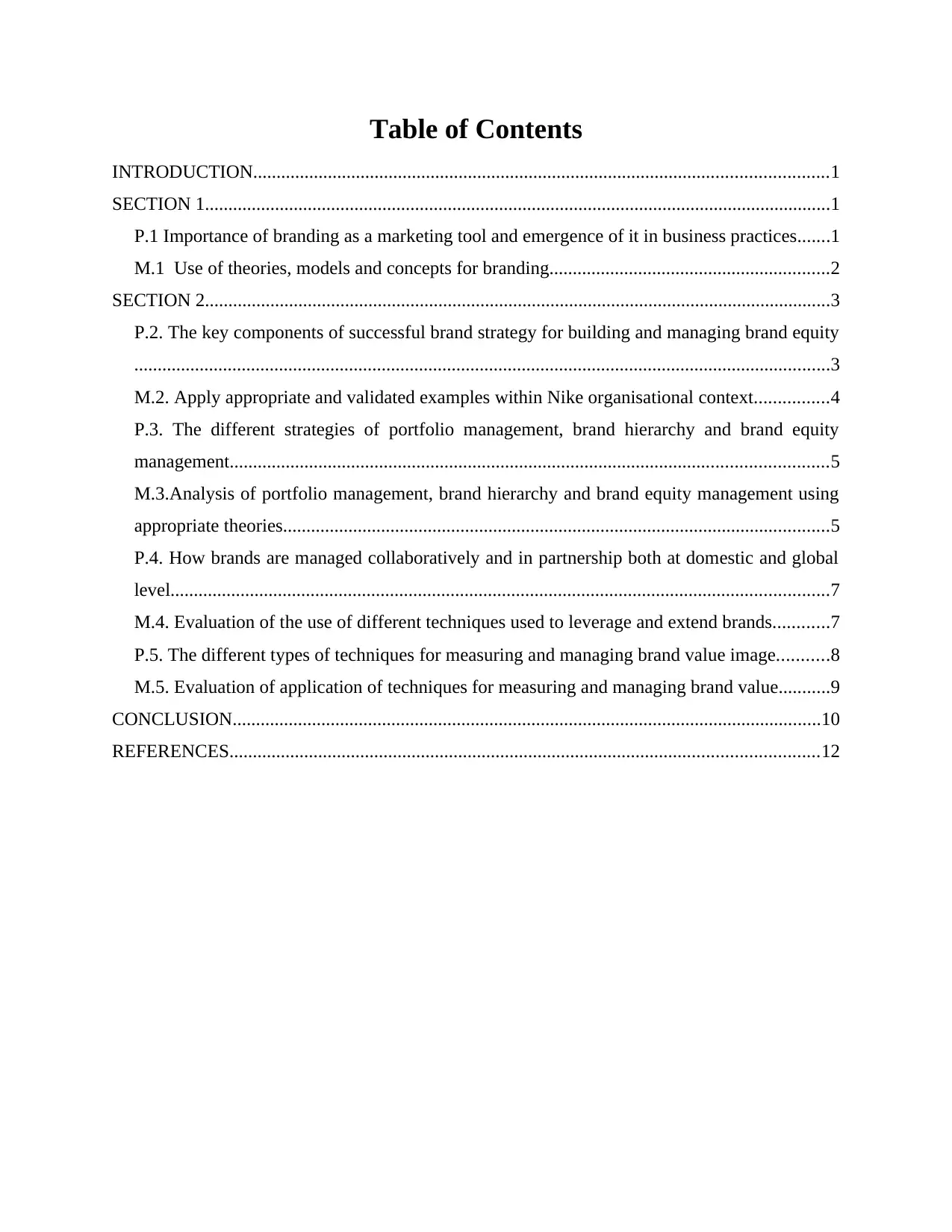
Table of Contents
INTRODUCTION...........................................................................................................................1
SECTION 1......................................................................................................................................1
P.1 Importance of branding as a marketing tool and emergence of it in business practices.......1
M.1 Use of theories, models and concepts for branding............................................................2
SECTION 2......................................................................................................................................3
P.2. The key components of successful brand strategy for building and managing brand equity
.....................................................................................................................................................3
M.2. Apply appropriate and validated examples within Nike organisational context................4
P.3. The different strategies of portfolio management, brand hierarchy and brand equity
management................................................................................................................................5
M.3.Analysis of portfolio management, brand hierarchy and brand equity management using
appropriate theories.....................................................................................................................5
P.4. How brands are managed collaboratively and in partnership both at domestic and global
level.............................................................................................................................................7
M.4. Evaluation of the use of different techniques used to leverage and extend brands............7
P.5. The different types of techniques for measuring and managing brand value image...........8
M.5. Evaluation of application of techniques for measuring and managing brand value...........9
CONCLUSION..............................................................................................................................10
REFERENCES..............................................................................................................................12
INTRODUCTION...........................................................................................................................1
SECTION 1......................................................................................................................................1
P.1 Importance of branding as a marketing tool and emergence of it in business practices.......1
M.1 Use of theories, models and concepts for branding............................................................2
SECTION 2......................................................................................................................................3
P.2. The key components of successful brand strategy for building and managing brand equity
.....................................................................................................................................................3
M.2. Apply appropriate and validated examples within Nike organisational context................4
P.3. The different strategies of portfolio management, brand hierarchy and brand equity
management................................................................................................................................5
M.3.Analysis of portfolio management, brand hierarchy and brand equity management using
appropriate theories.....................................................................................................................5
P.4. How brands are managed collaboratively and in partnership both at domestic and global
level.............................................................................................................................................7
M.4. Evaluation of the use of different techniques used to leverage and extend brands............7
P.5. The different types of techniques for measuring and managing brand value image...........8
M.5. Evaluation of application of techniques for measuring and managing brand value...........9
CONCLUSION..............................................................................................................................10
REFERENCES..............................................................................................................................12
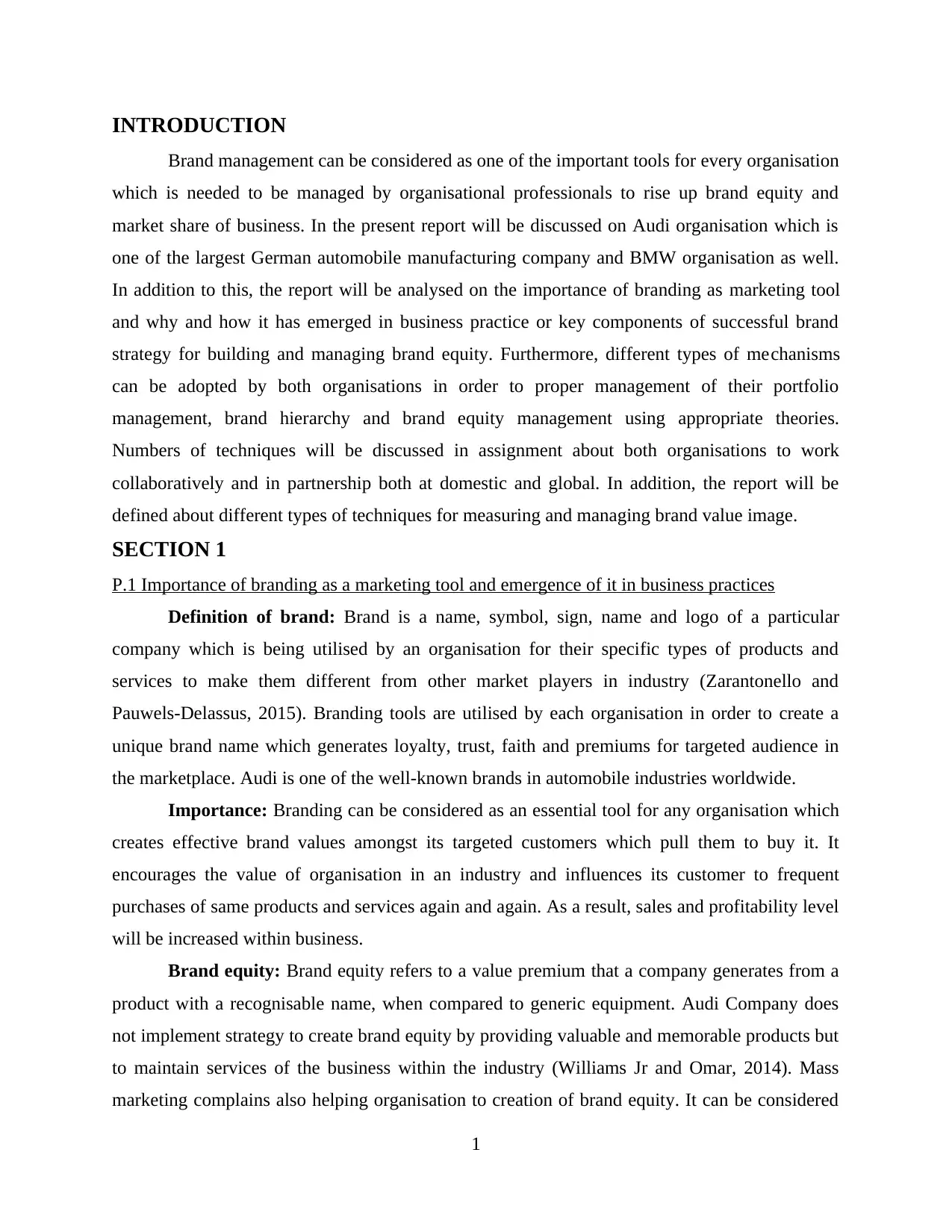
INTRODUCTION
Brand management can be considered as one of the important tools for every organisation
which is needed to be managed by organisational professionals to rise up brand equity and
market share of business. In the present report will be discussed on Audi organisation which is
one of the largest German automobile manufacturing company and BMW organisation as well.
In addition to this, the report will be analysed on the importance of branding as marketing tool
and why and how it has emerged in business practice or key components of successful brand
strategy for building and managing brand equity. Furthermore, different types of mechanisms
can be adopted by both organisations in order to proper management of their portfolio
management, brand hierarchy and brand equity management using appropriate theories.
Numbers of techniques will be discussed in assignment about both organisations to work
collaboratively and in partnership both at domestic and global. In addition, the report will be
defined about different types of techniques for measuring and managing brand value image.
SECTION 1
P.1 Importance of branding as a marketing tool and emergence of it in business practices
Definition of brand: Brand is a name, symbol, sign, name and logo of a particular
company which is being utilised by an organisation for their specific types of products and
services to make them different from other market players in industry (Zarantonello and
Pauwels-Delassus, 2015). Branding tools are utilised by each organisation in order to create a
unique brand name which generates loyalty, trust, faith and premiums for targeted audience in
the marketplace. Audi is one of the well-known brands in automobile industries worldwide.
Importance: Branding can be considered as an essential tool for any organisation which
creates effective brand values amongst its targeted customers which pull them to buy it. It
encourages the value of organisation in an industry and influences its customer to frequent
purchases of same products and services again and again. As a result, sales and profitability level
will be increased within business.
Brand equity: Brand equity refers to a value premium that a company generates from a
product with a recognisable name, when compared to generic equipment. Audi Company does
not implement strategy to create brand equity by providing valuable and memorable products but
to maintain services of the business within the industry (Williams Jr and Omar, 2014). Mass
marketing complains also helping organisation to creation of brand equity. It can be considered
1
Brand management can be considered as one of the important tools for every organisation
which is needed to be managed by organisational professionals to rise up brand equity and
market share of business. In the present report will be discussed on Audi organisation which is
one of the largest German automobile manufacturing company and BMW organisation as well.
In addition to this, the report will be analysed on the importance of branding as marketing tool
and why and how it has emerged in business practice or key components of successful brand
strategy for building and managing brand equity. Furthermore, different types of mechanisms
can be adopted by both organisations in order to proper management of their portfolio
management, brand hierarchy and brand equity management using appropriate theories.
Numbers of techniques will be discussed in assignment about both organisations to work
collaboratively and in partnership both at domestic and global. In addition, the report will be
defined about different types of techniques for measuring and managing brand value image.
SECTION 1
P.1 Importance of branding as a marketing tool and emergence of it in business practices
Definition of brand: Brand is a name, symbol, sign, name and logo of a particular
company which is being utilised by an organisation for their specific types of products and
services to make them different from other market players in industry (Zarantonello and
Pauwels-Delassus, 2015). Branding tools are utilised by each organisation in order to create a
unique brand name which generates loyalty, trust, faith and premiums for targeted audience in
the marketplace. Audi is one of the well-known brands in automobile industries worldwide.
Importance: Branding can be considered as an essential tool for any organisation which
creates effective brand values amongst its targeted customers which pull them to buy it. It
encourages the value of organisation in an industry and influences its customer to frequent
purchases of same products and services again and again. As a result, sales and profitability level
will be increased within business.
Brand equity: Brand equity refers to a value premium that a company generates from a
product with a recognisable name, when compared to generic equipment. Audi Company does
not implement strategy to create brand equity by providing valuable and memorable products but
to maintain services of the business within the industry (Williams Jr and Omar, 2014). Mass
marketing complains also helping organisation to creation of brand equity. It can be considered
1
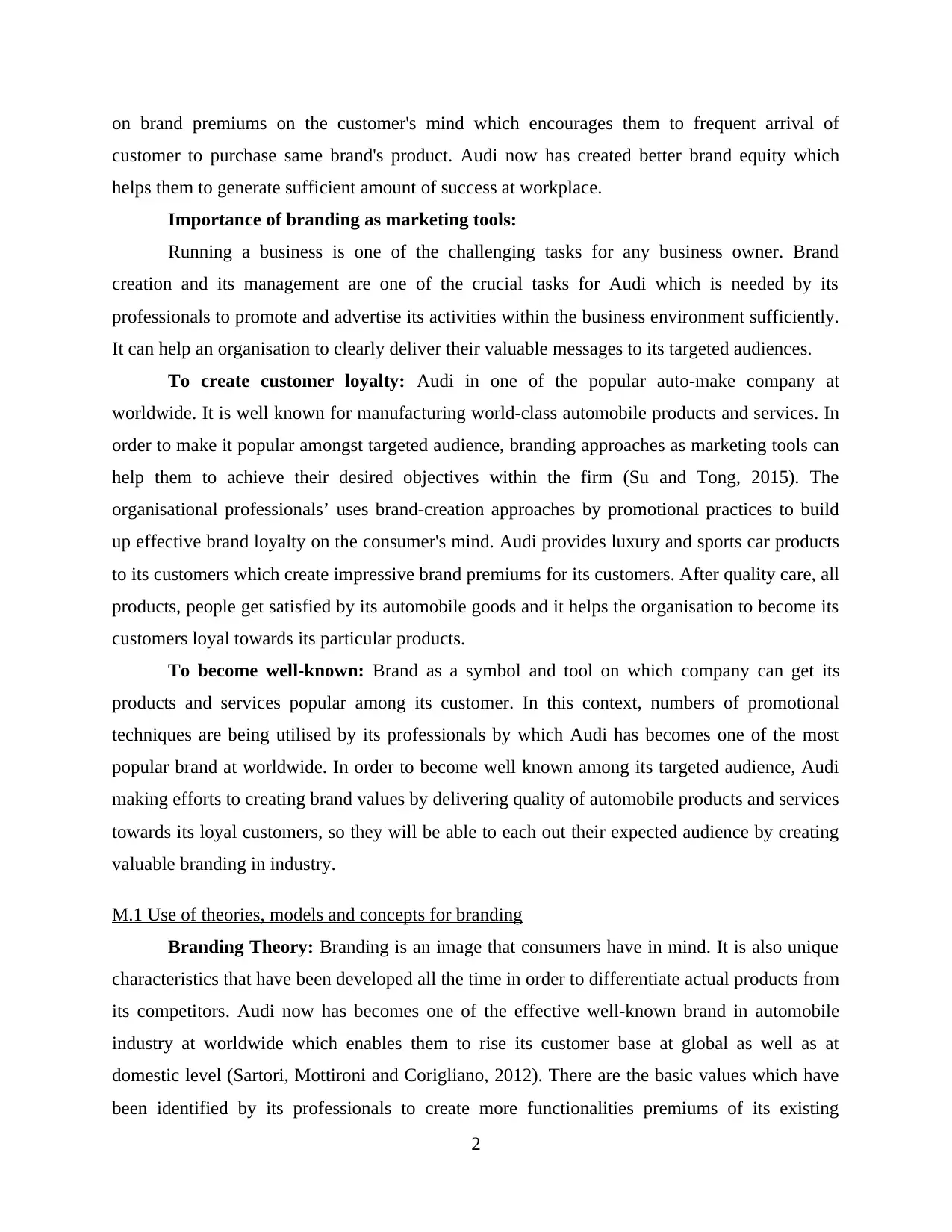
on brand premiums on the customer's mind which encourages them to frequent arrival of
customer to purchase same brand's product. Audi now has created better brand equity which
helps them to generate sufficient amount of success at workplace.
Importance of branding as marketing tools:
Running a business is one of the challenging tasks for any business owner. Brand
creation and its management are one of the crucial tasks for Audi which is needed by its
professionals to promote and advertise its activities within the business environment sufficiently.
It can help an organisation to clearly deliver their valuable messages to its targeted audiences.
To create customer loyalty: Audi in one of the popular auto-make company at
worldwide. It is well known for manufacturing world-class automobile products and services. In
order to make it popular amongst targeted audience, branding approaches as marketing tools can
help them to achieve their desired objectives within the firm (Su and Tong, 2015). The
organisational professionals’ uses brand-creation approaches by promotional practices to build
up effective brand loyalty on the consumer's mind. Audi provides luxury and sports car products
to its customers which create impressive brand premiums for its customers. After quality care, all
products, people get satisfied by its automobile goods and it helps the organisation to become its
customers loyal towards its particular products.
To become well-known: Brand as a symbol and tool on which company can get its
products and services popular among its customer. In this context, numbers of promotional
techniques are being utilised by its professionals by which Audi has becomes one of the most
popular brand at worldwide. In order to become well known among its targeted audience, Audi
making efforts to creating brand values by delivering quality of automobile products and services
towards its loyal customers, so they will be able to each out their expected audience by creating
valuable branding in industry.
M.1 Use of theories, models and concepts for branding
Branding Theory: Branding is an image that consumers have in mind. It is also unique
characteristics that have been developed all the time in order to differentiate actual products from
its competitors. Audi now has becomes one of the effective well-known brand in automobile
industry at worldwide which enables them to rise its customer base at global as well as at
domestic level (Sartori, Mottironi and Corigliano, 2012). There are the basic values which have
been identified by its professionals to create more functionalities premiums of its existing
2
customer to purchase same brand's product. Audi now has created better brand equity which
helps them to generate sufficient amount of success at workplace.
Importance of branding as marketing tools:
Running a business is one of the challenging tasks for any business owner. Brand
creation and its management are one of the crucial tasks for Audi which is needed by its
professionals to promote and advertise its activities within the business environment sufficiently.
It can help an organisation to clearly deliver their valuable messages to its targeted audiences.
To create customer loyalty: Audi in one of the popular auto-make company at
worldwide. It is well known for manufacturing world-class automobile products and services. In
order to make it popular amongst targeted audience, branding approaches as marketing tools can
help them to achieve their desired objectives within the firm (Su and Tong, 2015). The
organisational professionals’ uses brand-creation approaches by promotional practices to build
up effective brand loyalty on the consumer's mind. Audi provides luxury and sports car products
to its customers which create impressive brand premiums for its customers. After quality care, all
products, people get satisfied by its automobile goods and it helps the organisation to become its
customers loyal towards its particular products.
To become well-known: Brand as a symbol and tool on which company can get its
products and services popular among its customer. In this context, numbers of promotional
techniques are being utilised by its professionals by which Audi has becomes one of the most
popular brand at worldwide. In order to become well known among its targeted audience, Audi
making efforts to creating brand values by delivering quality of automobile products and services
towards its loyal customers, so they will be able to each out their expected audience by creating
valuable branding in industry.
M.1 Use of theories, models and concepts for branding
Branding Theory: Branding is an image that consumers have in mind. It is also unique
characteristics that have been developed all the time in order to differentiate actual products from
its competitors. Audi now has becomes one of the effective well-known brand in automobile
industry at worldwide which enables them to rise its customer base at global as well as at
domestic level (Sartori, Mottironi and Corigliano, 2012). There are the basic values which have
been identified by its professionals to create more functionalities premiums of its existing
2
Secure Best Marks with AI Grader
Need help grading? Try our AI Grader for instant feedback on your assignments.
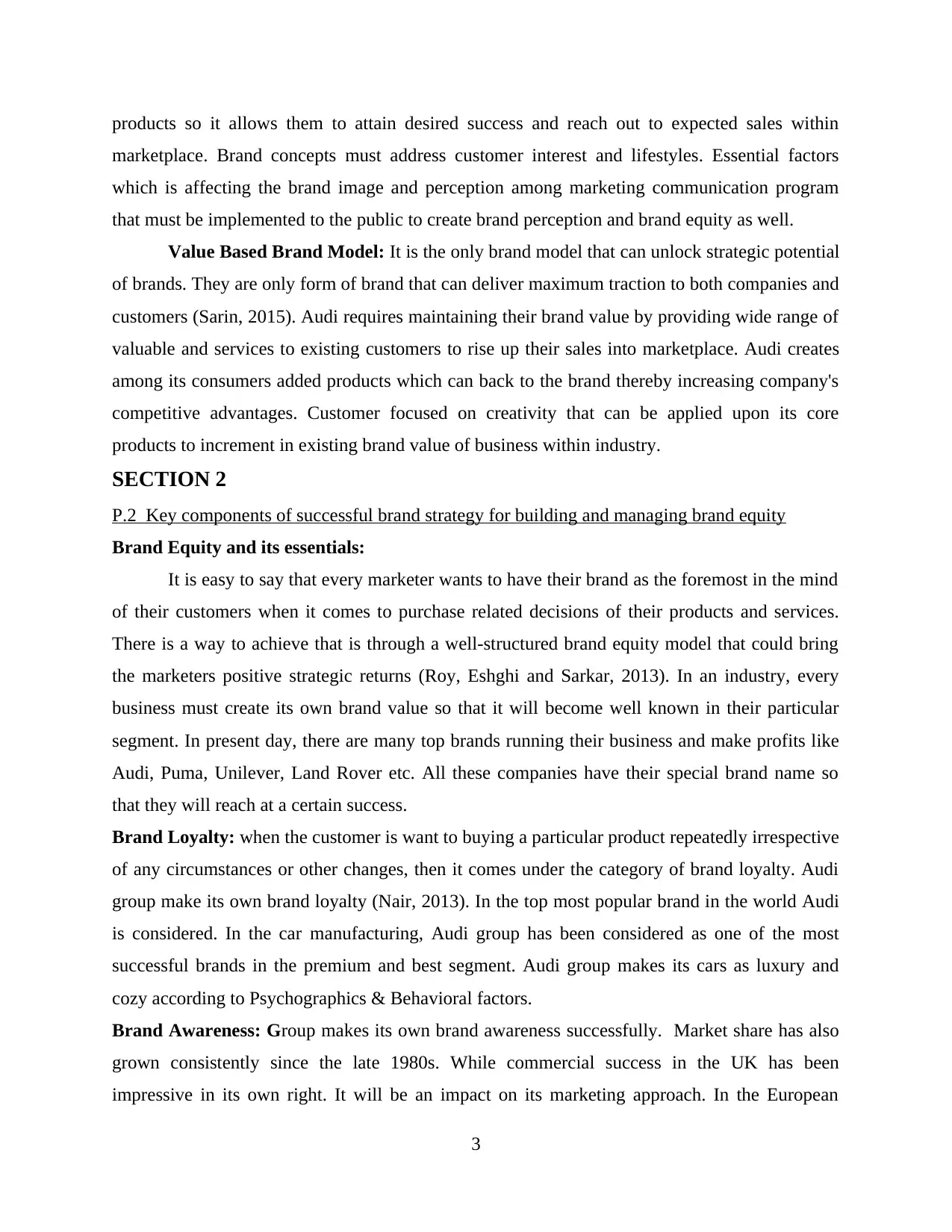
products so it allows them to attain desired success and reach out to expected sales within
marketplace. Brand concepts must address customer interest and lifestyles. Essential factors
which is affecting the brand image and perception among marketing communication program
that must be implemented to the public to create brand perception and brand equity as well.
Value Based Brand Model: It is the only brand model that can unlock strategic potential
of brands. They are only form of brand that can deliver maximum traction to both companies and
customers (Sarin, 2015). Audi requires maintaining their brand value by providing wide range of
valuable and services to existing customers to rise up their sales into marketplace. Audi creates
among its consumers added products which can back to the brand thereby increasing company's
competitive advantages. Customer focused on creativity that can be applied upon its core
products to increment in existing brand value of business within industry.
SECTION 2
P.2 Key components of successful brand strategy for building and managing brand equity
Brand Equity and its essentials:
It is easy to say that every marketer wants to have their brand as the foremost in the mind
of their customers when it comes to purchase related decisions of their products and services.
There is a way to achieve that is through a well-structured brand equity model that could bring
the marketers positive strategic returns (Roy, Eshghi and Sarkar, 2013). In an industry, every
business must create its own brand value so that it will become well known in their particular
segment. In present day, there are many top brands running their business and make profits like
Audi, Puma, Unilever, Land Rover etc. All these companies have their special brand name so
that they will reach at a certain success.
Brand Loyalty: when the customer is want to buying a particular product repeatedly irrespective
of any circumstances or other changes, then it comes under the category of brand loyalty. Audi
group make its own brand loyalty (Nair, 2013). In the top most popular brand in the world Audi
is considered. In the car manufacturing, Audi group has been considered as one of the most
successful brands in the premium and best segment. Audi group makes its cars as luxury and
cozy according to Psychographics & Behavioral factors.
Brand Awareness: Group makes its own brand awareness successfully. Market share has also
grown consistently since the late 1980s. While commercial success in the UK has been
impressive in its own right. It will be an impact on its marketing approach. In the European
3
marketplace. Brand concepts must address customer interest and lifestyles. Essential factors
which is affecting the brand image and perception among marketing communication program
that must be implemented to the public to create brand perception and brand equity as well.
Value Based Brand Model: It is the only brand model that can unlock strategic potential
of brands. They are only form of brand that can deliver maximum traction to both companies and
customers (Sarin, 2015). Audi requires maintaining their brand value by providing wide range of
valuable and services to existing customers to rise up their sales into marketplace. Audi creates
among its consumers added products which can back to the brand thereby increasing company's
competitive advantages. Customer focused on creativity that can be applied upon its core
products to increment in existing brand value of business within industry.
SECTION 2
P.2 Key components of successful brand strategy for building and managing brand equity
Brand Equity and its essentials:
It is easy to say that every marketer wants to have their brand as the foremost in the mind
of their customers when it comes to purchase related decisions of their products and services.
There is a way to achieve that is through a well-structured brand equity model that could bring
the marketers positive strategic returns (Roy, Eshghi and Sarkar, 2013). In an industry, every
business must create its own brand value so that it will become well known in their particular
segment. In present day, there are many top brands running their business and make profits like
Audi, Puma, Unilever, Land Rover etc. All these companies have their special brand name so
that they will reach at a certain success.
Brand Loyalty: when the customer is want to buying a particular product repeatedly irrespective
of any circumstances or other changes, then it comes under the category of brand loyalty. Audi
group make its own brand loyalty (Nair, 2013). In the top most popular brand in the world Audi
is considered. In the car manufacturing, Audi group has been considered as one of the most
successful brands in the premium and best segment. Audi group makes its cars as luxury and
cozy according to Psychographics & Behavioral factors.
Brand Awareness: Group makes its own brand awareness successfully. Market share has also
grown consistently since the late 1980s. While commercial success in the UK has been
impressive in its own right. It will be an impact on its marketing approach. In the European
3
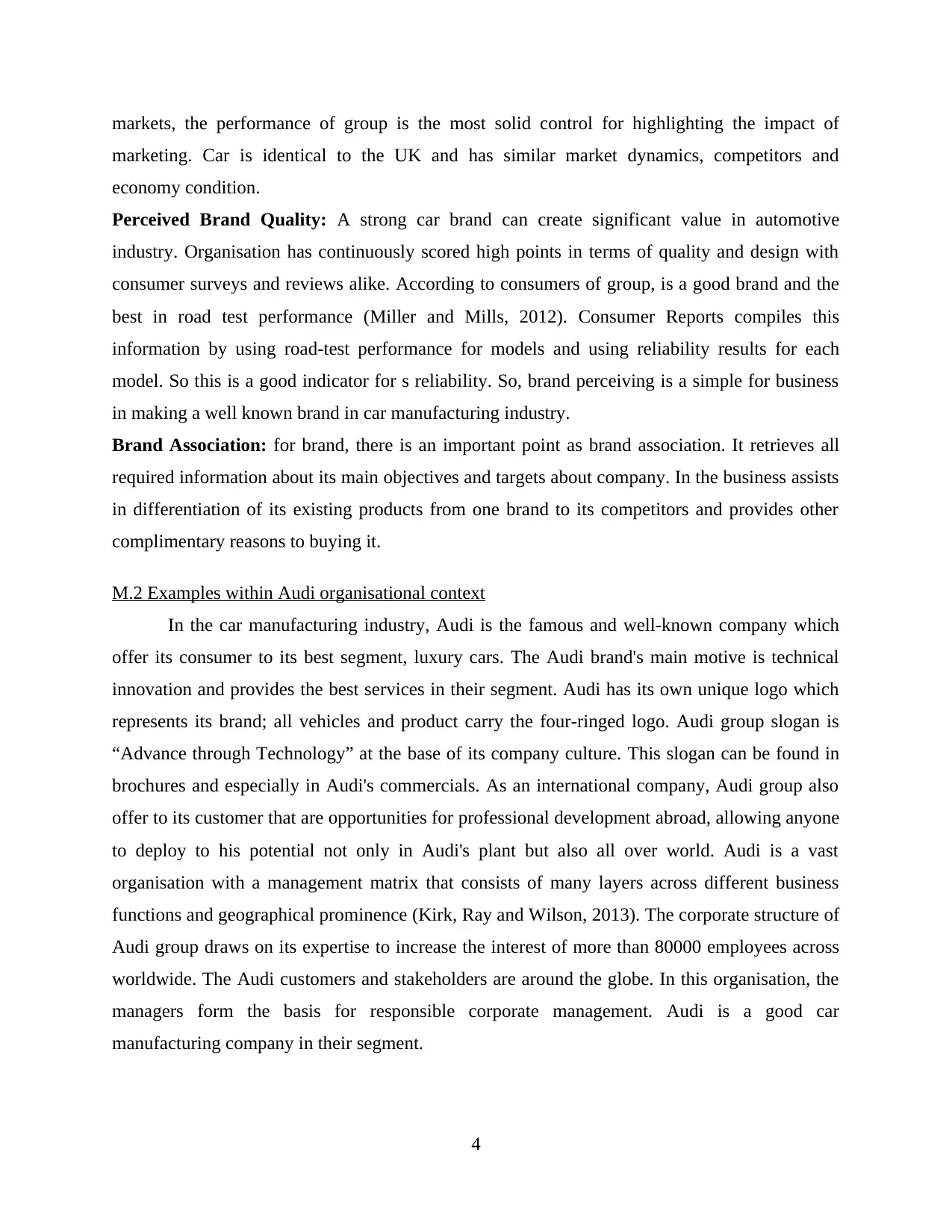
markets, the performance of group is the most solid control for highlighting the impact of
marketing. Car is identical to the UK and has similar market dynamics, competitors and
economy condition.
Perceived Brand Quality: A strong car brand can create significant value in automotive
industry. Organisation has continuously scored high points in terms of quality and design with
consumer surveys and reviews alike. According to consumers of group, is a good brand and the
best in road test performance (Miller and Mills, 2012). Consumer Reports compiles this
information by using road-test performance for models and using reliability results for each
model. So this is a good indicator for s reliability. So, brand perceiving is a simple for business
in making a well known brand in car manufacturing industry.
Brand Association: for brand, there is an important point as brand association. It retrieves all
required information about its main objectives and targets about company. In the business assists
in differentiation of its existing products from one brand to its competitors and provides other
complimentary reasons to buying it.
M.2 Examples within Audi organisational context
In the car manufacturing industry, Audi is the famous and well-known company which
offer its consumer to its best segment, luxury cars. The Audi brand's main motive is technical
innovation and provides the best services in their segment. Audi has its own unique logo which
represents its brand; all vehicles and product carry the four-ringed logo. Audi group slogan is
“Advance through Technology” at the base of its company culture. This slogan can be found in
brochures and especially in Audi's commercials. As an international company, Audi group also
offer to its customer that are opportunities for professional development abroad, allowing anyone
to deploy to his potential not only in Audi's plant but also all over world. Audi is a vast
organisation with a management matrix that consists of many layers across different business
functions and geographical prominence (Kirk, Ray and Wilson, 2013). The corporate structure of
Audi group draws on its expertise to increase the interest of more than 80000 employees across
worldwide. The Audi customers and stakeholders are around the globe. In this organisation, the
managers form the basis for responsible corporate management. Audi is a good car
manufacturing company in their segment.
4
marketing. Car is identical to the UK and has similar market dynamics, competitors and
economy condition.
Perceived Brand Quality: A strong car brand can create significant value in automotive
industry. Organisation has continuously scored high points in terms of quality and design with
consumer surveys and reviews alike. According to consumers of group, is a good brand and the
best in road test performance (Miller and Mills, 2012). Consumer Reports compiles this
information by using road-test performance for models and using reliability results for each
model. So this is a good indicator for s reliability. So, brand perceiving is a simple for business
in making a well known brand in car manufacturing industry.
Brand Association: for brand, there is an important point as brand association. It retrieves all
required information about its main objectives and targets about company. In the business assists
in differentiation of its existing products from one brand to its competitors and provides other
complimentary reasons to buying it.
M.2 Examples within Audi organisational context
In the car manufacturing industry, Audi is the famous and well-known company which
offer its consumer to its best segment, luxury cars. The Audi brand's main motive is technical
innovation and provides the best services in their segment. Audi has its own unique logo which
represents its brand; all vehicles and product carry the four-ringed logo. Audi group slogan is
“Advance through Technology” at the base of its company culture. This slogan can be found in
brochures and especially in Audi's commercials. As an international company, Audi group also
offer to its customer that are opportunities for professional development abroad, allowing anyone
to deploy to his potential not only in Audi's plant but also all over world. Audi is a vast
organisation with a management matrix that consists of many layers across different business
functions and geographical prominence (Kirk, Ray and Wilson, 2013). The corporate structure of
Audi group draws on its expertise to increase the interest of more than 80000 employees across
worldwide. The Audi customers and stakeholders are around the globe. In this organisation, the
managers form the basis for responsible corporate management. Audi is a good car
manufacturing company in their segment.
4
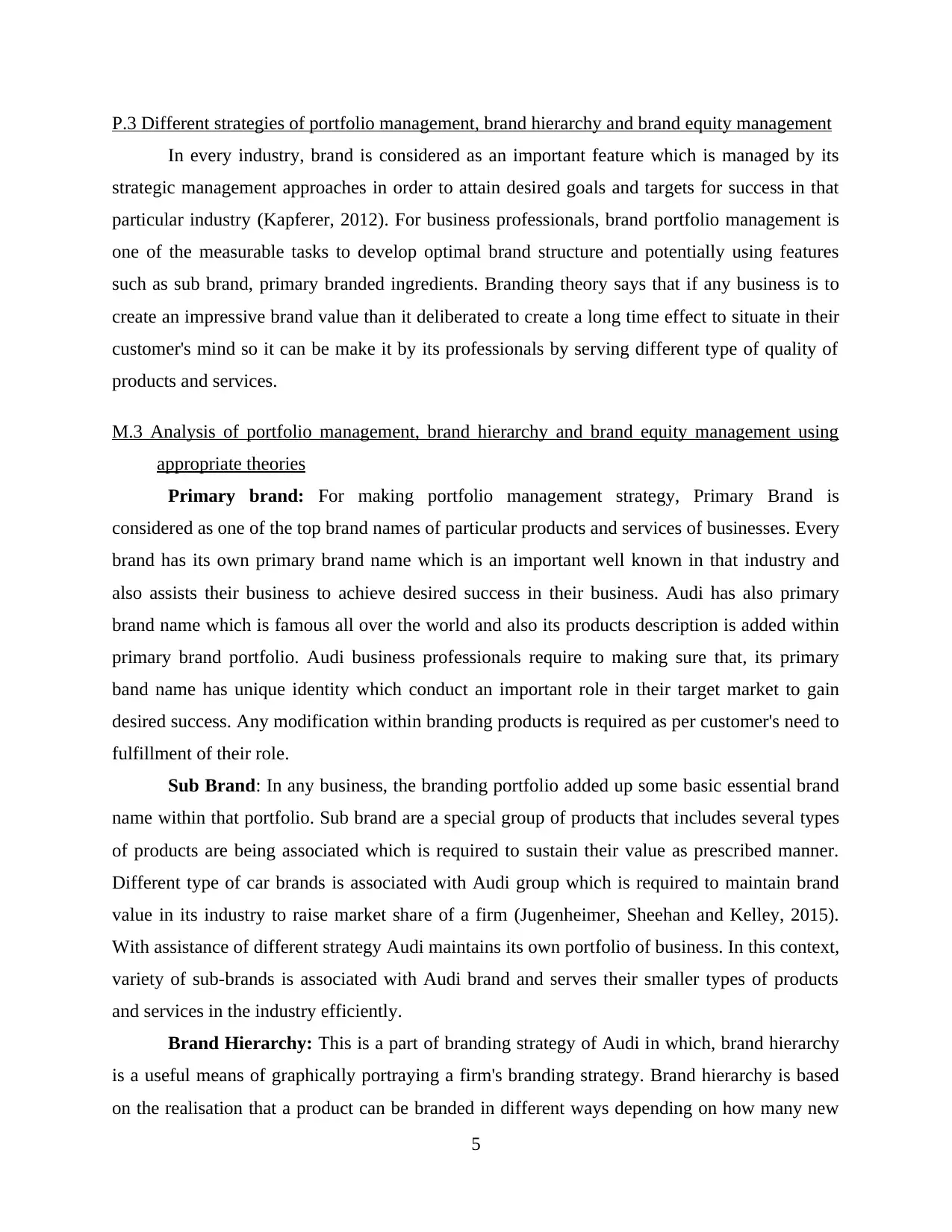
P.3 Different strategies of portfolio management, brand hierarchy and brand equity management
In every industry, brand is considered as an important feature which is managed by its
strategic management approaches in order to attain desired goals and targets for success in that
particular industry (Kapferer, 2012). For business professionals, brand portfolio management is
one of the measurable tasks to develop optimal brand structure and potentially using features
such as sub brand, primary branded ingredients. Branding theory says that if any business is to
create an impressive brand value than it deliberated to create a long time effect to situate in their
customer's mind so it can be make it by its professionals by serving different type of quality of
products and services.
M.3 Analysis of portfolio management, brand hierarchy and brand equity management using
appropriate theories
Primary brand: For making portfolio management strategy, Primary Brand is
considered as one of the top brand names of particular products and services of businesses. Every
brand has its own primary brand name which is an important well known in that industry and
also assists their business to achieve desired success in their business. Audi has also primary
brand name which is famous all over the world and also its products description is added within
primary brand portfolio. Audi business professionals require to making sure that, its primary
band name has unique identity which conduct an important role in their target market to gain
desired success. Any modification within branding products is required as per customer's need to
fulfillment of their role.
Sub Brand: In any business, the branding portfolio added up some basic essential brand
name within that portfolio. Sub brand are a special group of products that includes several types
of products are being associated which is required to sustain their value as prescribed manner.
Different type of car brands is associated with Audi group which is required to maintain brand
value in its industry to raise market share of a firm (Jugenheimer, Sheehan and Kelley, 2015).
With assistance of different strategy Audi maintains its own portfolio of business. In this context,
variety of sub-brands is associated with Audi brand and serves their smaller types of products
and services in the industry efficiently.
Brand Hierarchy: This is a part of branding strategy of Audi in which, brand hierarchy
is a useful means of graphically portraying a firm's branding strategy. Brand hierarchy is based
on the realisation that a product can be branded in different ways depending on how many new
5
In every industry, brand is considered as an important feature which is managed by its
strategic management approaches in order to attain desired goals and targets for success in that
particular industry (Kapferer, 2012). For business professionals, brand portfolio management is
one of the measurable tasks to develop optimal brand structure and potentially using features
such as sub brand, primary branded ingredients. Branding theory says that if any business is to
create an impressive brand value than it deliberated to create a long time effect to situate in their
customer's mind so it can be make it by its professionals by serving different type of quality of
products and services.
M.3 Analysis of portfolio management, brand hierarchy and brand equity management using
appropriate theories
Primary brand: For making portfolio management strategy, Primary Brand is
considered as one of the top brand names of particular products and services of businesses. Every
brand has its own primary brand name which is an important well known in that industry and
also assists their business to achieve desired success in their business. Audi has also primary
brand name which is famous all over the world and also its products description is added within
primary brand portfolio. Audi business professionals require to making sure that, its primary
band name has unique identity which conduct an important role in their target market to gain
desired success. Any modification within branding products is required as per customer's need to
fulfillment of their role.
Sub Brand: In any business, the branding portfolio added up some basic essential brand
name within that portfolio. Sub brand are a special group of products that includes several types
of products are being associated which is required to sustain their value as prescribed manner.
Different type of car brands is associated with Audi group which is required to maintain brand
value in its industry to raise market share of a firm (Jugenheimer, Sheehan and Kelley, 2015).
With assistance of different strategy Audi maintains its own portfolio of business. In this context,
variety of sub-brands is associated with Audi brand and serves their smaller types of products
and services in the industry efficiently.
Brand Hierarchy: This is a part of branding strategy of Audi in which, brand hierarchy
is a useful means of graphically portraying a firm's branding strategy. Brand hierarchy is based
on the realisation that a product can be branded in different ways depending on how many new
5
Paraphrase This Document
Need a fresh take? Get an instant paraphrase of this document with our AI Paraphraser
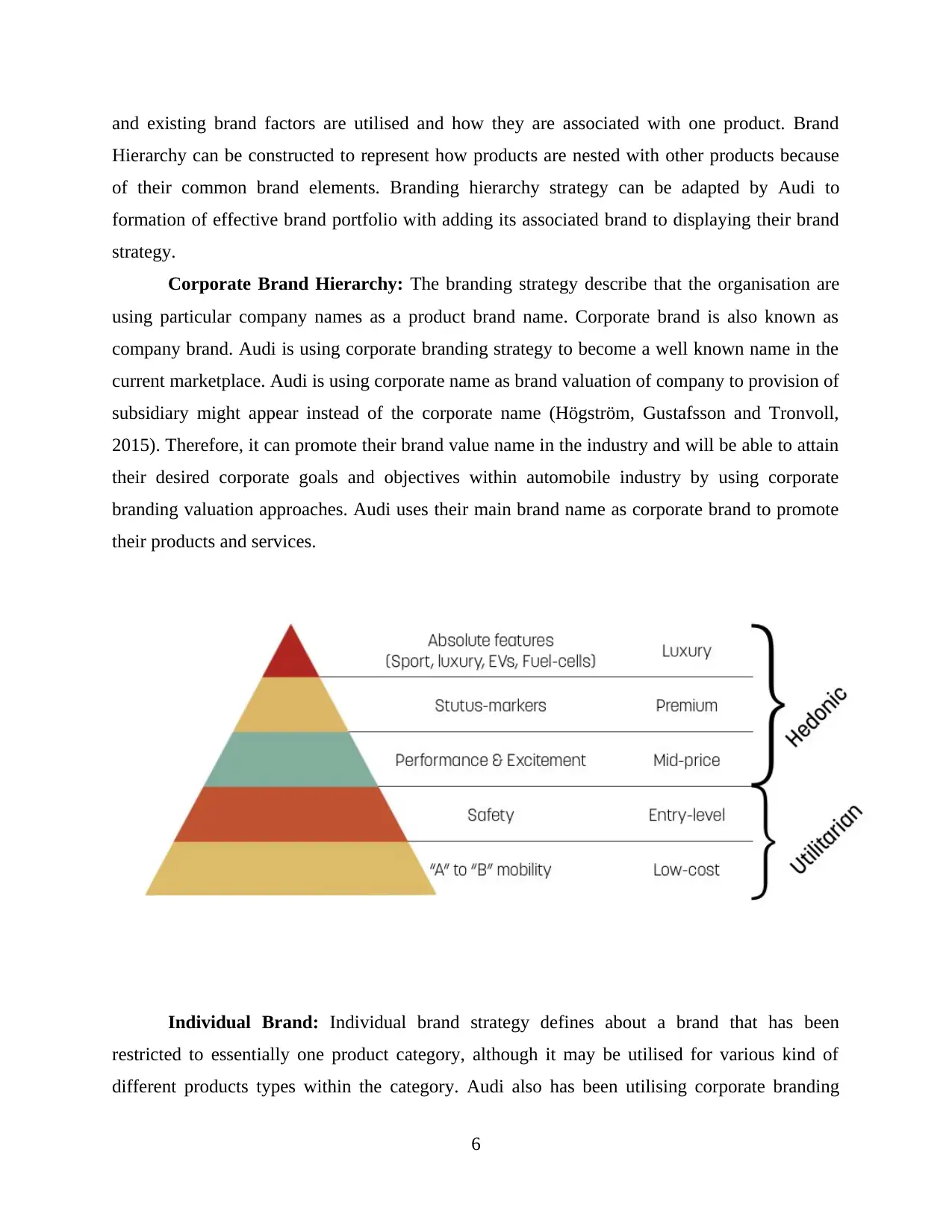
and existing brand factors are utilised and how they are associated with one product. Brand
Hierarchy can be constructed to represent how products are nested with other products because
of their common brand elements. Branding hierarchy strategy can be adapted by Audi to
formation of effective brand portfolio with adding its associated brand to displaying their brand
strategy.
Corporate Brand Hierarchy: The branding strategy describe that the organisation are
using particular company names as a product brand name. Corporate brand is also known as
company brand. Audi is using corporate branding strategy to become a well known name in the
current marketplace. Audi is using corporate name as brand valuation of company to provision of
subsidiary might appear instead of the corporate name (Högström, Gustafsson and Tronvoll,
2015). Therefore, it can promote their brand value name in the industry and will be able to attain
their desired corporate goals and objectives within automobile industry by using corporate
branding valuation approaches. Audi uses their main brand name as corporate brand to promote
their products and services.
Individual Brand: Individual brand strategy defines about a brand that has been
restricted to essentially one product category, although it may be utilised for various kind of
different products types within the category. Audi also has been utilising corporate branding
6
Hierarchy can be constructed to represent how products are nested with other products because
of their common brand elements. Branding hierarchy strategy can be adapted by Audi to
formation of effective brand portfolio with adding its associated brand to displaying their brand
strategy.
Corporate Brand Hierarchy: The branding strategy describe that the organisation are
using particular company names as a product brand name. Corporate brand is also known as
company brand. Audi is using corporate branding strategy to become a well known name in the
current marketplace. Audi is using corporate name as brand valuation of company to provision of
subsidiary might appear instead of the corporate name (Högström, Gustafsson and Tronvoll,
2015). Therefore, it can promote their brand value name in the industry and will be able to attain
their desired corporate goals and objectives within automobile industry by using corporate
branding valuation approaches. Audi uses their main brand name as corporate brand to promote
their products and services.
Individual Brand: Individual brand strategy defines about a brand that has been
restricted to essentially one product category, although it may be utilised for various kind of
different products types within the category. Audi also has been utilising corporate branding
6

strategy to support their marketing practices becoming it more popular among its customers.
Audi use an individual brand name as upon its existing products to being well known as
individual brand. As per this strategy, organisation has become well known across the world’s
automobile marketplace.
Brand Equity Management: Brand equity framework must identify the necessity of
customer in the creation and management of brand equity. In order to manage the brand equity of
Audi, it being essential for start with a strong sense to recognising of the brand's standing in the
minds of consumers. Audi has been now maintaining high level of brand equity in industry by
delivering valuable automobile products to its loyal customers. For brand equity management,
Audi organisational professionals require measuring, compare their brand awareness from its
competitors, and then identify the brand loyalty from its existing customers. Superior quality of
vehicle product can be charged a price premium. Therefore, by considering all brand equity
management elements, its professionals may manage it within the firm efficiently.
P.4 Brands are managed collaboratively and in partnership both at domestic and global level
Domestic Level: Numbers of different types of techniques can be adopted by Audi and
BMW in respect to grow their business sector. At domestic level, both brands are utilising the
strategy to implement variety of branding management strategies to teach desired success within
industry. Both organisations are being utilisation of adopt collaborative approaches to maintain
brand awareness within current marketplace which encourages its customer more to purchase
Audi brand premium vehicle's products (Hennigs, Wiedmann and Klarmann, 2012). Thus, at the
domestic and global level, Audi brand followed brand management approaches to sustain in a
competitive automobile industry at international and state level efficiently.
M.4 Evaluation of different techniques used to leverage and extend brands
Collaborative Innovation: In domestic marketplace, Audi is being utilised strategy
which is making collaborative innovation with other top brands and local organisations which is
already operating in the automobile sector of the nation. With the assistance of same-segmented
organisation which is also operating in the automobile sector within both organisations at
domestic level, they can approach them for giving help the existing brands at marketplace in
order to work with collaboration in industry (Urde, Baumgarth and Merrilees, 2013). Audi
implements strategy to find out invention and innovation within its core business products to
7
Audi use an individual brand name as upon its existing products to being well known as
individual brand. As per this strategy, organisation has become well known across the world’s
automobile marketplace.
Brand Equity Management: Brand equity framework must identify the necessity of
customer in the creation and management of brand equity. In order to manage the brand equity of
Audi, it being essential for start with a strong sense to recognising of the brand's standing in the
minds of consumers. Audi has been now maintaining high level of brand equity in industry by
delivering valuable automobile products to its loyal customers. For brand equity management,
Audi organisational professionals require measuring, compare their brand awareness from its
competitors, and then identify the brand loyalty from its existing customers. Superior quality of
vehicle product can be charged a price premium. Therefore, by considering all brand equity
management elements, its professionals may manage it within the firm efficiently.
P.4 Brands are managed collaboratively and in partnership both at domestic and global level
Domestic Level: Numbers of different types of techniques can be adopted by Audi and
BMW in respect to grow their business sector. At domestic level, both brands are utilising the
strategy to implement variety of branding management strategies to teach desired success within
industry. Both organisations are being utilisation of adopt collaborative approaches to maintain
brand awareness within current marketplace which encourages its customer more to purchase
Audi brand premium vehicle's products (Hennigs, Wiedmann and Klarmann, 2012). Thus, at the
domestic and global level, Audi brand followed brand management approaches to sustain in a
competitive automobile industry at international and state level efficiently.
M.4 Evaluation of different techniques used to leverage and extend brands
Collaborative Innovation: In domestic marketplace, Audi is being utilised strategy
which is making collaborative innovation with other top brands and local organisations which is
already operating in the automobile sector of the nation. With the assistance of same-segmented
organisation which is also operating in the automobile sector within both organisations at
domestic level, they can approach them for giving help the existing brands at marketplace in
order to work with collaboration in industry (Urde, Baumgarth and Merrilees, 2013). Audi
implements strategy to find out invention and innovation within its core business products to
7
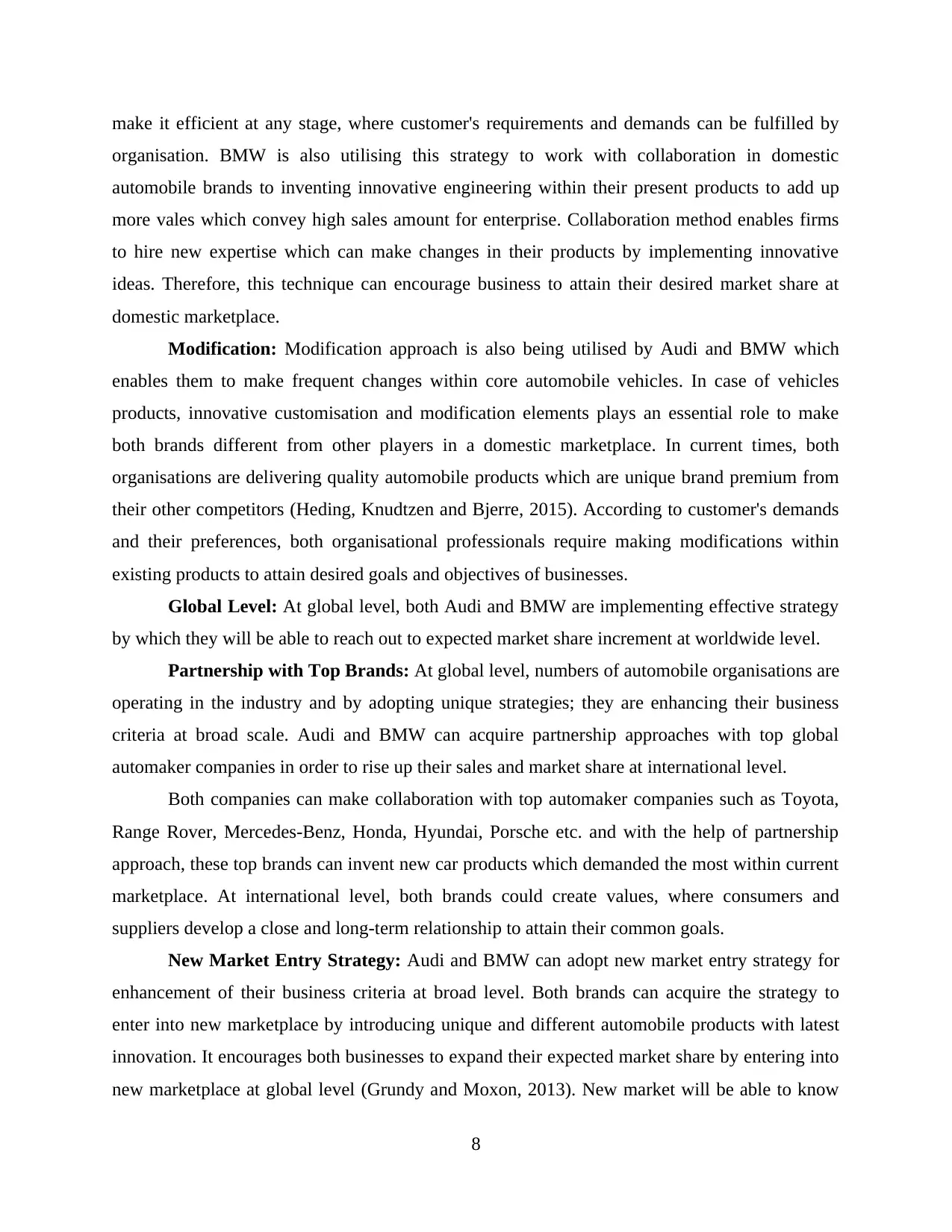
make it efficient at any stage, where customer's requirements and demands can be fulfilled by
organisation. BMW is also utilising this strategy to work with collaboration in domestic
automobile brands to inventing innovative engineering within their present products to add up
more vales which convey high sales amount for enterprise. Collaboration method enables firms
to hire new expertise which can make changes in their products by implementing innovative
ideas. Therefore, this technique can encourage business to attain their desired market share at
domestic marketplace.
Modification: Modification approach is also being utilised by Audi and BMW which
enables them to make frequent changes within core automobile vehicles. In case of vehicles
products, innovative customisation and modification elements plays an essential role to make
both brands different from other players in a domestic marketplace. In current times, both
organisations are delivering quality automobile products which are unique brand premium from
their other competitors (Heding, Knudtzen and Bjerre, 2015). According to customer's demands
and their preferences, both organisational professionals require making modifications within
existing products to attain desired goals and objectives of businesses.
Global Level: At global level, both Audi and BMW are implementing effective strategy
by which they will be able to reach out to expected market share increment at worldwide level.
Partnership with Top Brands: At global level, numbers of automobile organisations are
operating in the industry and by adopting unique strategies; they are enhancing their business
criteria at broad scale. Audi and BMW can acquire partnership approaches with top global
automaker companies in order to rise up their sales and market share at international level.
Both companies can make collaboration with top automaker companies such as Toyota,
Range Rover, Mercedes-Benz, Honda, Hyundai, Porsche etc. and with the help of partnership
approach, these top brands can invent new car products which demanded the most within current
marketplace. At international level, both brands could create values, where consumers and
suppliers develop a close and long-term relationship to attain their common goals.
New Market Entry Strategy: Audi and BMW can adopt new market entry strategy for
enhancement of their business criteria at broad level. Both brands can acquire the strategy to
enter into new marketplace by introducing unique and different automobile products with latest
innovation. It encourages both businesses to expand their expected market share by entering into
new marketplace at global level (Grundy and Moxon, 2013). New market will be able to know
8
organisation. BMW is also utilising this strategy to work with collaboration in domestic
automobile brands to inventing innovative engineering within their present products to add up
more vales which convey high sales amount for enterprise. Collaboration method enables firms
to hire new expertise which can make changes in their products by implementing innovative
ideas. Therefore, this technique can encourage business to attain their desired market share at
domestic marketplace.
Modification: Modification approach is also being utilised by Audi and BMW which
enables them to make frequent changes within core automobile vehicles. In case of vehicles
products, innovative customisation and modification elements plays an essential role to make
both brands different from other players in a domestic marketplace. In current times, both
organisations are delivering quality automobile products which are unique brand premium from
their other competitors (Heding, Knudtzen and Bjerre, 2015). According to customer's demands
and their preferences, both organisational professionals require making modifications within
existing products to attain desired goals and objectives of businesses.
Global Level: At global level, both Audi and BMW are implementing effective strategy
by which they will be able to reach out to expected market share increment at worldwide level.
Partnership with Top Brands: At global level, numbers of automobile organisations are
operating in the industry and by adopting unique strategies; they are enhancing their business
criteria at broad scale. Audi and BMW can acquire partnership approaches with top global
automaker companies in order to rise up their sales and market share at international level.
Both companies can make collaboration with top automaker companies such as Toyota,
Range Rover, Mercedes-Benz, Honda, Hyundai, Porsche etc. and with the help of partnership
approach, these top brands can invent new car products which demanded the most within current
marketplace. At international level, both brands could create values, where consumers and
suppliers develop a close and long-term relationship to attain their common goals.
New Market Entry Strategy: Audi and BMW can adopt new market entry strategy for
enhancement of their business criteria at broad level. Both brands can acquire the strategy to
enter into new marketplace by introducing unique and different automobile products with latest
innovation. It encourages both businesses to expand their expected market share by entering into
new marketplace at global level (Grundy and Moxon, 2013). New market will be able to know
8
Secure Best Marks with AI Grader
Need help grading? Try our AI Grader for instant feedback on your assignments.
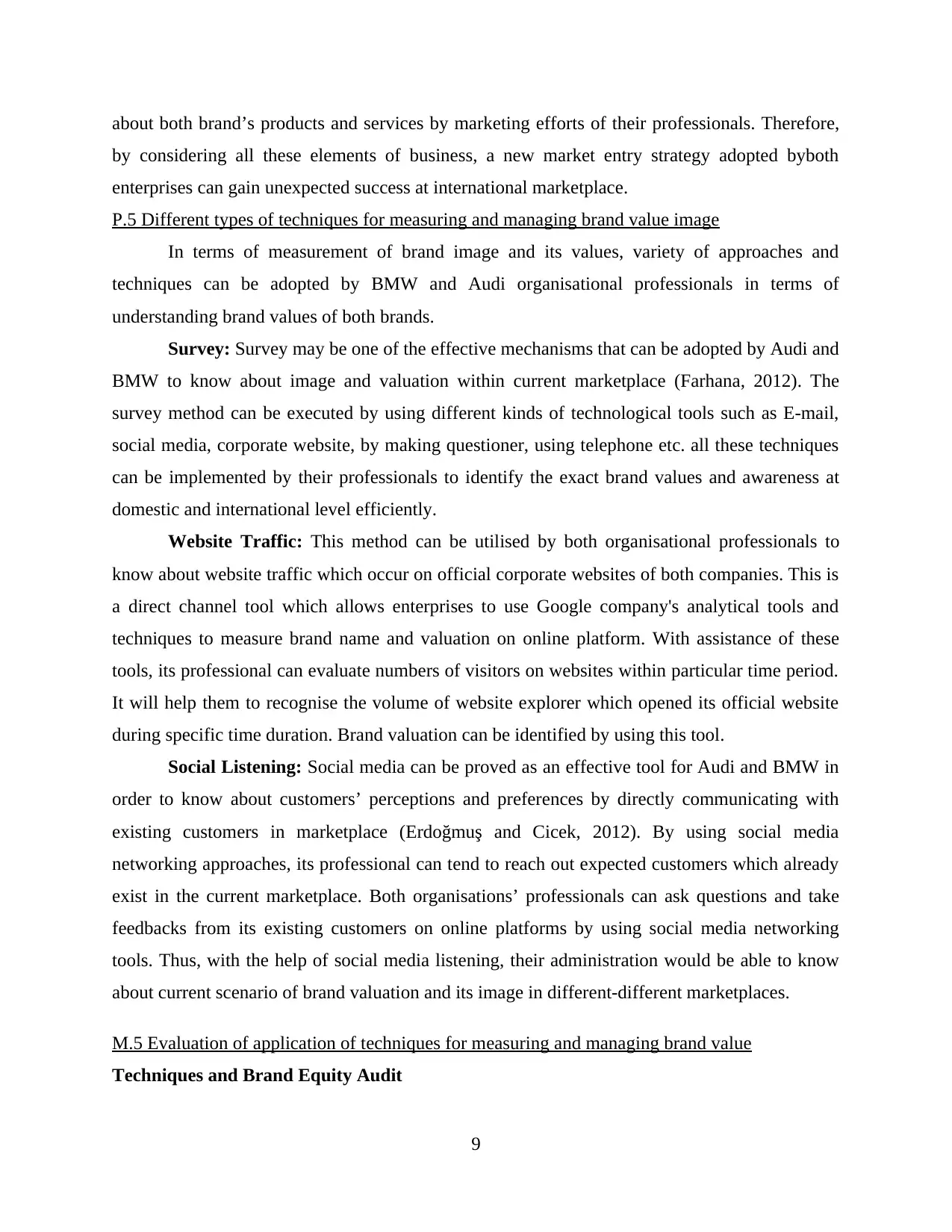
about both brand’s products and services by marketing efforts of their professionals. Therefore,
by considering all these elements of business, a new market entry strategy adopted byboth
enterprises can gain unexpected success at international marketplace.
P.5 Different types of techniques for measuring and managing brand value image
In terms of measurement of brand image and its values, variety of approaches and
techniques can be adopted by BMW and Audi organisational professionals in terms of
understanding brand values of both brands.
Survey: Survey may be one of the effective mechanisms that can be adopted by Audi and
BMW to know about image and valuation within current marketplace (Farhana, 2012). The
survey method can be executed by using different kinds of technological tools such as E-mail,
social media, corporate website, by making questioner, using telephone etc. all these techniques
can be implemented by their professionals to identify the exact brand values and awareness at
domestic and international level efficiently.
Website Traffic: This method can be utilised by both organisational professionals to
know about website traffic which occur on official corporate websites of both companies. This is
a direct channel tool which allows enterprises to use Google company's analytical tools and
techniques to measure brand name and valuation on online platform. With assistance of these
tools, its professional can evaluate numbers of visitors on websites within particular time period.
It will help them to recognise the volume of website explorer which opened its official website
during specific time duration. Brand valuation can be identified by using this tool.
Social Listening: Social media can be proved as an effective tool for Audi and BMW in
order to know about customers’ perceptions and preferences by directly communicating with
existing customers in marketplace (Erdoğmuş and Cicek, 2012). By using social media
networking approaches, its professional can tend to reach out expected customers which already
exist in the current marketplace. Both organisations’ professionals can ask questions and take
feedbacks from its existing customers on online platforms by using social media networking
tools. Thus, with the help of social media listening, their administration would be able to know
about current scenario of brand valuation and its image in different-different marketplaces.
M.5 Evaluation of application of techniques for measuring and managing brand value
Techniques and Brand Equity Audit
9
by considering all these elements of business, a new market entry strategy adopted byboth
enterprises can gain unexpected success at international marketplace.
P.5 Different types of techniques for measuring and managing brand value image
In terms of measurement of brand image and its values, variety of approaches and
techniques can be adopted by BMW and Audi organisational professionals in terms of
understanding brand values of both brands.
Survey: Survey may be one of the effective mechanisms that can be adopted by Audi and
BMW to know about image and valuation within current marketplace (Farhana, 2012). The
survey method can be executed by using different kinds of technological tools such as E-mail,
social media, corporate website, by making questioner, using telephone etc. all these techniques
can be implemented by their professionals to identify the exact brand values and awareness at
domestic and international level efficiently.
Website Traffic: This method can be utilised by both organisational professionals to
know about website traffic which occur on official corporate websites of both companies. This is
a direct channel tool which allows enterprises to use Google company's analytical tools and
techniques to measure brand name and valuation on online platform. With assistance of these
tools, its professional can evaluate numbers of visitors on websites within particular time period.
It will help them to recognise the volume of website explorer which opened its official website
during specific time duration. Brand valuation can be identified by using this tool.
Social Listening: Social media can be proved as an effective tool for Audi and BMW in
order to know about customers’ perceptions and preferences by directly communicating with
existing customers in marketplace (Erdoğmuş and Cicek, 2012). By using social media
networking approaches, its professional can tend to reach out expected customers which already
exist in the current marketplace. Both organisations’ professionals can ask questions and take
feedbacks from its existing customers on online platforms by using social media networking
tools. Thus, with the help of social media listening, their administration would be able to know
about current scenario of brand valuation and its image in different-different marketplaces.
M.5 Evaluation of application of techniques for measuring and managing brand value
Techniques and Brand Equity Audit
9
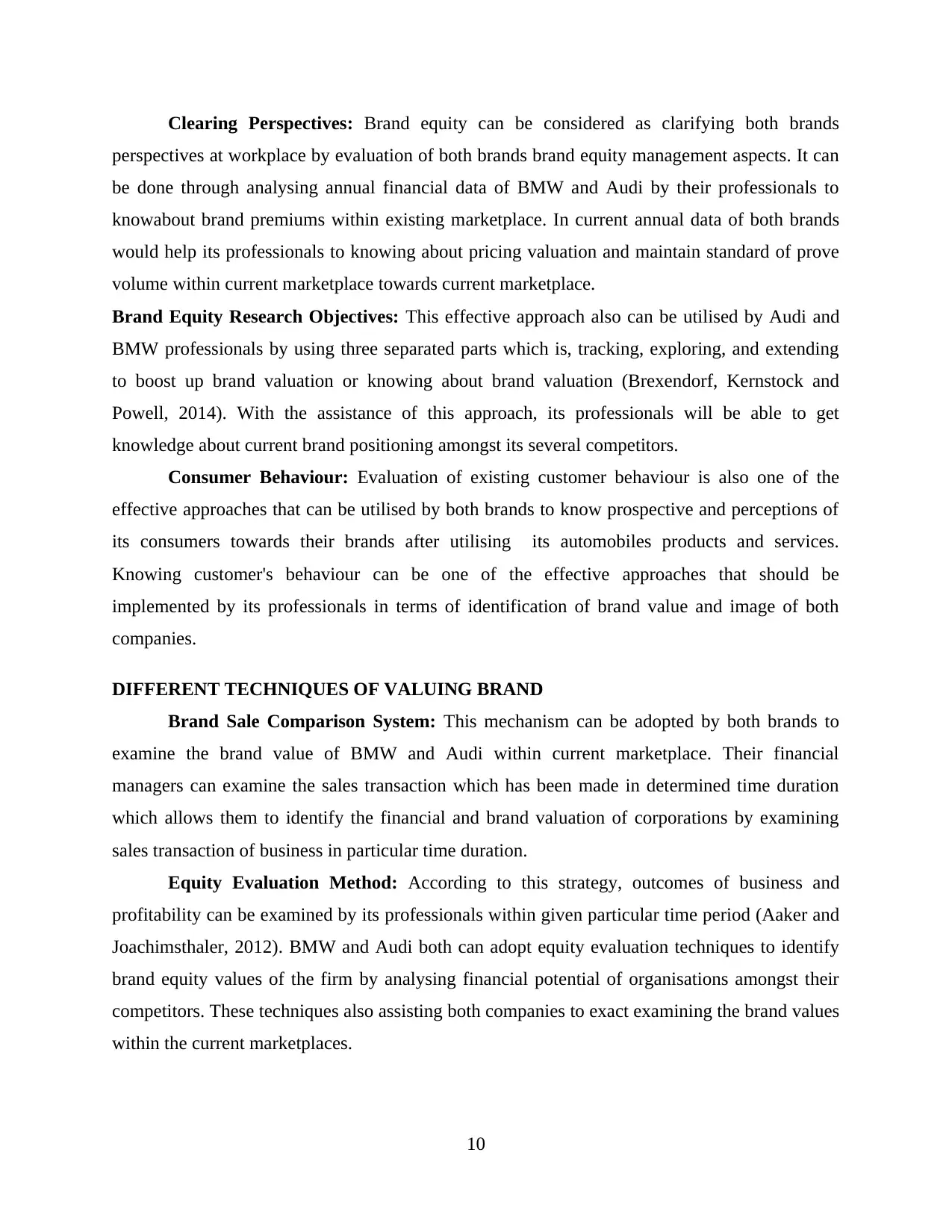
Clearing Perspectives: Brand equity can be considered as clarifying both brands
perspectives at workplace by evaluation of both brands brand equity management aspects. It can
be done through analysing annual financial data of BMW and Audi by their professionals to
knowabout brand premiums within existing marketplace. In current annual data of both brands
would help its professionals to knowing about pricing valuation and maintain standard of prove
volume within current marketplace towards current marketplace.
Brand Equity Research Objectives: This effective approach also can be utilised by Audi and
BMW professionals by using three separated parts which is, tracking, exploring, and extending
to boost up brand valuation or knowing about brand valuation (Brexendorf, Kernstock and
Powell, 2014). With the assistance of this approach, its professionals will be able to get
knowledge about current brand positioning amongst its several competitors.
Consumer Behaviour: Evaluation of existing customer behaviour is also one of the
effective approaches that can be utilised by both brands to know prospective and perceptions of
its consumers towards their brands after utilising its automobiles products and services.
Knowing customer's behaviour can be one of the effective approaches that should be
implemented by its professionals in terms of identification of brand value and image of both
companies.
DIFFERENT TECHNIQUES OF VALUING BRAND
Brand Sale Comparison System: This mechanism can be adopted by both brands to
examine the brand value of BMW and Audi within current marketplace. Their financial
managers can examine the sales transaction which has been made in determined time duration
which allows them to identify the financial and brand valuation of corporations by examining
sales transaction of business in particular time duration.
Equity Evaluation Method: According to this strategy, outcomes of business and
profitability can be examined by its professionals within given particular time period (Aaker and
Joachimsthaler, 2012). BMW and Audi both can adopt equity evaluation techniques to identify
brand equity values of the firm by analysing financial potential of organisations amongst their
competitors. These techniques also assisting both companies to exact examining the brand values
within the current marketplaces.
10
perspectives at workplace by evaluation of both brands brand equity management aspects. It can
be done through analysing annual financial data of BMW and Audi by their professionals to
knowabout brand premiums within existing marketplace. In current annual data of both brands
would help its professionals to knowing about pricing valuation and maintain standard of prove
volume within current marketplace towards current marketplace.
Brand Equity Research Objectives: This effective approach also can be utilised by Audi and
BMW professionals by using three separated parts which is, tracking, exploring, and extending
to boost up brand valuation or knowing about brand valuation (Brexendorf, Kernstock and
Powell, 2014). With the assistance of this approach, its professionals will be able to get
knowledge about current brand positioning amongst its several competitors.
Consumer Behaviour: Evaluation of existing customer behaviour is also one of the
effective approaches that can be utilised by both brands to know prospective and perceptions of
its consumers towards their brands after utilising its automobiles products and services.
Knowing customer's behaviour can be one of the effective approaches that should be
implemented by its professionals in terms of identification of brand value and image of both
companies.
DIFFERENT TECHNIQUES OF VALUING BRAND
Brand Sale Comparison System: This mechanism can be adopted by both brands to
examine the brand value of BMW and Audi within current marketplace. Their financial
managers can examine the sales transaction which has been made in determined time duration
which allows them to identify the financial and brand valuation of corporations by examining
sales transaction of business in particular time duration.
Equity Evaluation Method: According to this strategy, outcomes of business and
profitability can be examined by its professionals within given particular time period (Aaker and
Joachimsthaler, 2012). BMW and Audi both can adopt equity evaluation techniques to identify
brand equity values of the firm by analysing financial potential of organisations amongst their
competitors. These techniques also assisting both companies to exact examining the brand values
within the current marketplaces.
10
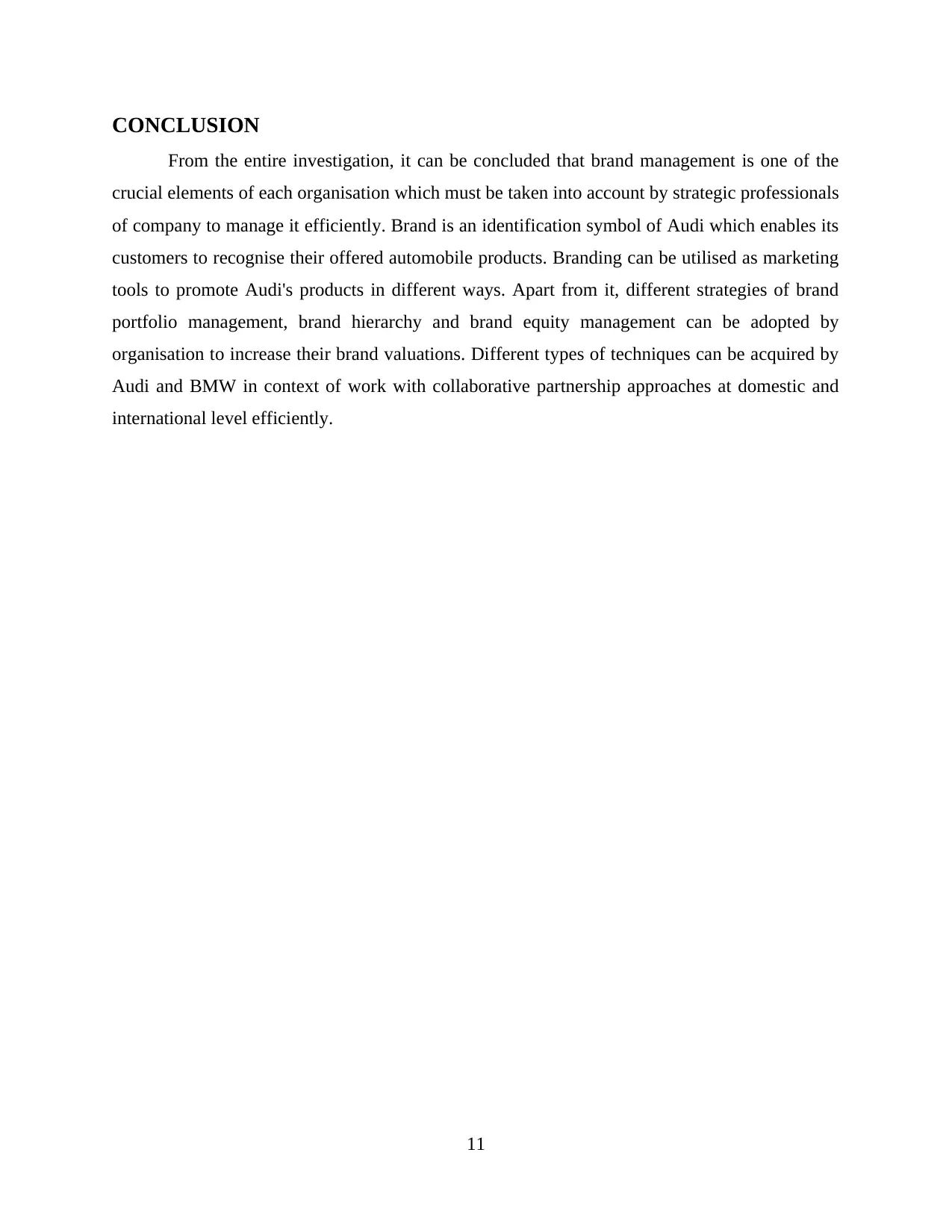
CONCLUSION
From the entire investigation, it can be concluded that brand management is one of the
crucial elements of each organisation which must be taken into account by strategic professionals
of company to manage it efficiently. Brand is an identification symbol of Audi which enables its
customers to recognise their offered automobile products. Branding can be utilised as marketing
tools to promote Audi's products in different ways. Apart from it, different strategies of brand
portfolio management, brand hierarchy and brand equity management can be adopted by
organisation to increase their brand valuations. Different types of techniques can be acquired by
Audi and BMW in context of work with collaborative partnership approaches at domestic and
international level efficiently.
11
From the entire investigation, it can be concluded that brand management is one of the
crucial elements of each organisation which must be taken into account by strategic professionals
of company to manage it efficiently. Brand is an identification symbol of Audi which enables its
customers to recognise their offered automobile products. Branding can be utilised as marketing
tools to promote Audi's products in different ways. Apart from it, different strategies of brand
portfolio management, brand hierarchy and brand equity management can be adopted by
organisation to increase their brand valuations. Different types of techniques can be acquired by
Audi and BMW in context of work with collaborative partnership approaches at domestic and
international level efficiently.
11
Paraphrase This Document
Need a fresh take? Get an instant paraphrase of this document with our AI Paraphraser

REFERENCES
Books and Journals
Aaker, D. A. and Joachimsthaler, E., 2012. Brand leadership. Simon and Schuster.
Brexendorf, T. O., Kernstock, J. and Powell, S.M., 2014. Future challenges and opportunities in
brand management: An introduction to a commemorative special issue.
Erdoğmuş, İ. E. and Cicek, M., 2012. The impact of social media marketing on brand loyalty.
Procedia-Social and Behavioral Sciences, 58, pp.1353-1360.
Farhana, M., 2012. Brand elements lead to brand equity: Differentiate or die. Information
management and business review, 4(4), pp.223-233.
Grundy, M. and Moxon, R., 2013. The effectiveness of airline crisis management on brand
protection: A case study of British Airways. Journal of Air Transport Management, 28,
pp.55-61.
Heding, T., Knudtzen, C. F. and Bjerre, M., 2015. Brand management: Research, theory and
practice. Routledge.
Hennigs, N., Wiedmann, K. P. and Klarmann, C., 2012. Luxury brands in the digital age–
exclusivity versus ubiquity. Marketing Review St. Gallen, 29(1), pp.30-35.
12
Books and Journals
Aaker, D. A. and Joachimsthaler, E., 2012. Brand leadership. Simon and Schuster.
Brexendorf, T. O., Kernstock, J. and Powell, S.M., 2014. Future challenges and opportunities in
brand management: An introduction to a commemorative special issue.
Erdoğmuş, İ. E. and Cicek, M., 2012. The impact of social media marketing on brand loyalty.
Procedia-Social and Behavioral Sciences, 58, pp.1353-1360.
Farhana, M., 2012. Brand elements lead to brand equity: Differentiate or die. Information
management and business review, 4(4), pp.223-233.
Grundy, M. and Moxon, R., 2013. The effectiveness of airline crisis management on brand
protection: A case study of British Airways. Journal of Air Transport Management, 28,
pp.55-61.
Heding, T., Knudtzen, C. F. and Bjerre, M., 2015. Brand management: Research, theory and
practice. Routledge.
Hennigs, N., Wiedmann, K. P. and Klarmann, C., 2012. Luxury brands in the digital age–
exclusivity versus ubiquity. Marketing Review St. Gallen, 29(1), pp.30-35.
12
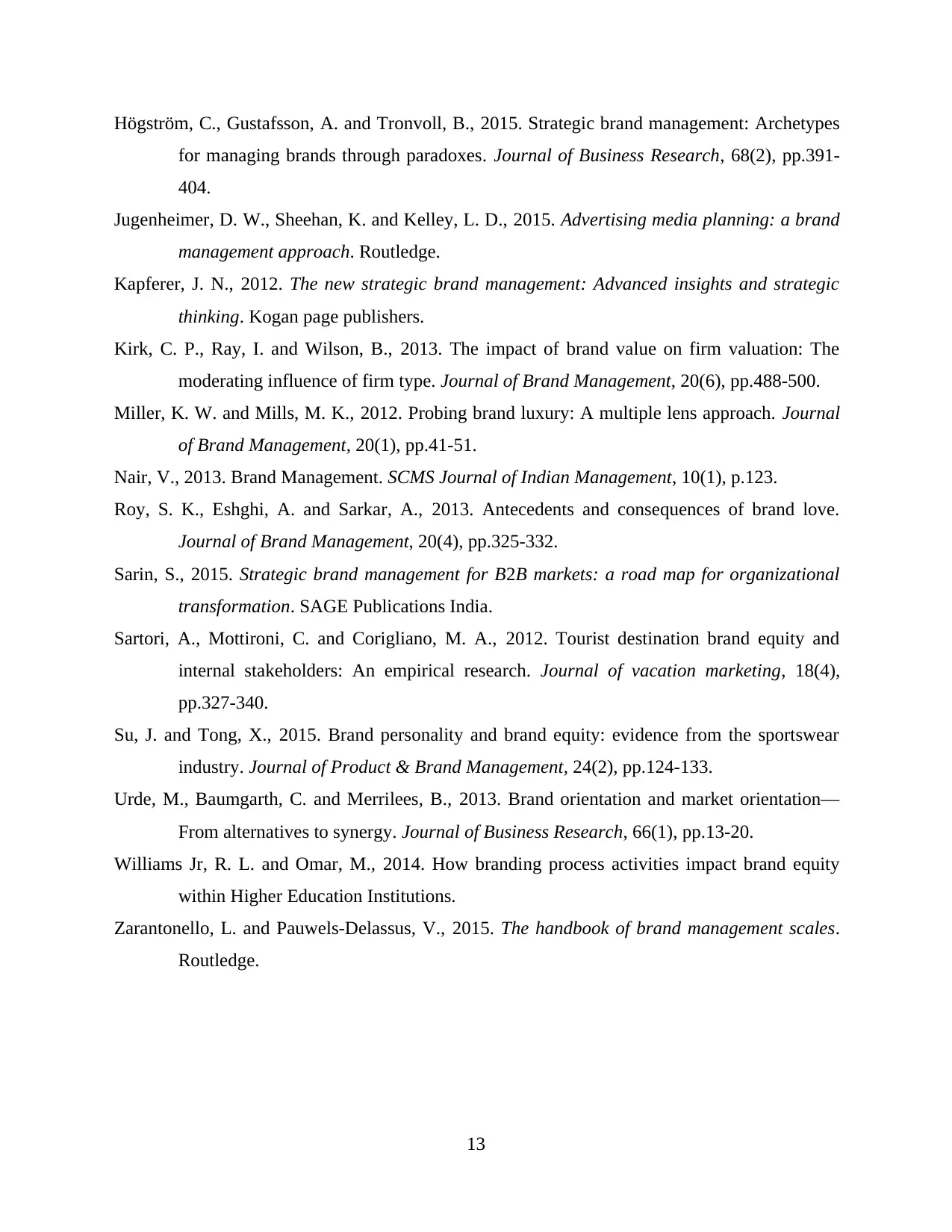
Högström, C., Gustafsson, A. and Tronvoll, B., 2015. Strategic brand management: Archetypes
for managing brands through paradoxes. Journal of Business Research, 68(2), pp.391-
404.
Jugenheimer, D. W., Sheehan, K. and Kelley, L. D., 2015. Advertising media planning: a brand
management approach. Routledge.
Kapferer, J. N., 2012. The new strategic brand management: Advanced insights and strategic
thinking. Kogan page publishers.
Kirk, C. P., Ray, I. and Wilson, B., 2013. The impact of brand value on firm valuation: The
moderating influence of firm type. Journal of Brand Management, 20(6), pp.488-500.
Miller, K. W. and Mills, M. K., 2012. Probing brand luxury: A multiple lens approach. Journal
of Brand Management, 20(1), pp.41-51.
Nair, V., 2013. Brand Management. SCMS Journal of Indian Management, 10(1), p.123.
Roy, S. K., Eshghi, A. and Sarkar, A., 2013. Antecedents and consequences of brand love.
Journal of Brand Management, 20(4), pp.325-332.
Sarin, S., 2015. Strategic brand management for B2B markets: a road map for organizational
transformation. SAGE Publications India.
Sartori, A., Mottironi, C. and Corigliano, M. A., 2012. Tourist destination brand equity and
internal stakeholders: An empirical research. Journal of vacation marketing, 18(4),
pp.327-340.
Su, J. and Tong, X., 2015. Brand personality and brand equity: evidence from the sportswear
industry. Journal of Product & Brand Management, 24(2), pp.124-133.
Urde, M., Baumgarth, C. and Merrilees, B., 2013. Brand orientation and market orientation—
From alternatives to synergy. Journal of Business Research, 66(1), pp.13-20.
Williams Jr, R. L. and Omar, M., 2014. How branding process activities impact brand equity
within Higher Education Institutions.
Zarantonello, L. and Pauwels-Delassus, V., 2015. The handbook of brand management scales.
Routledge.
13
for managing brands through paradoxes. Journal of Business Research, 68(2), pp.391-
404.
Jugenheimer, D. W., Sheehan, K. and Kelley, L. D., 2015. Advertising media planning: a brand
management approach. Routledge.
Kapferer, J. N., 2012. The new strategic brand management: Advanced insights and strategic
thinking. Kogan page publishers.
Kirk, C. P., Ray, I. and Wilson, B., 2013. The impact of brand value on firm valuation: The
moderating influence of firm type. Journal of Brand Management, 20(6), pp.488-500.
Miller, K. W. and Mills, M. K., 2012. Probing brand luxury: A multiple lens approach. Journal
of Brand Management, 20(1), pp.41-51.
Nair, V., 2013. Brand Management. SCMS Journal of Indian Management, 10(1), p.123.
Roy, S. K., Eshghi, A. and Sarkar, A., 2013. Antecedents and consequences of brand love.
Journal of Brand Management, 20(4), pp.325-332.
Sarin, S., 2015. Strategic brand management for B2B markets: a road map for organizational
transformation. SAGE Publications India.
Sartori, A., Mottironi, C. and Corigliano, M. A., 2012. Tourist destination brand equity and
internal stakeholders: An empirical research. Journal of vacation marketing, 18(4),
pp.327-340.
Su, J. and Tong, X., 2015. Brand personality and brand equity: evidence from the sportswear
industry. Journal of Product & Brand Management, 24(2), pp.124-133.
Urde, M., Baumgarth, C. and Merrilees, B., 2013. Brand orientation and market orientation—
From alternatives to synergy. Journal of Business Research, 66(1), pp.13-20.
Williams Jr, R. L. and Omar, M., 2014. How branding process activities impact brand equity
within Higher Education Institutions.
Zarantonello, L. and Pauwels-Delassus, V., 2015. The handbook of brand management scales.
Routledge.
13
1 out of 15
Related Documents
Your All-in-One AI-Powered Toolkit for Academic Success.
+13062052269
info@desklib.com
Available 24*7 on WhatsApp / Email
![[object Object]](/_next/static/media/star-bottom.7253800d.svg)
Unlock your academic potential
© 2024 | Zucol Services PVT LTD | All rights reserved.





